
Robotaxi leader Waymo is expanding its ridesharing service to a much wider area in San Francisco.
The Alphabet-owned company announced the larger service area on Monday in a message on X, the social media platform formerly known as Twitter. It means that riders can now take trips in Waymo’s driverless vehicles within a 47-square-mile area of the city.
While Waymo had been offering rides to several thousand customers mainly in San Francisco’s northeastern neighborhoods, the expansion brings the ridesharing service to tens of thousands of riders, TechCrunch reported.
The move by Waymo comes amid protests by some in the city who are worried that the technology powering the autonomous vehicles isn’t yet ready for use on public streets.
Concerns have been raised following a number of high-profile incidents involving self-driving vehicles operated by rival autonomous car firm Cruise, which is owned by General Motors.
As recently as last week, a Cruise vehicle ran over a pedestrian right after she was hit by another vehicle, sending her into the path of the autonomous car. The Cruise car braked hard but came to a halt with one of its wheels on the pedestrian’s leg, pinning her to the ground.
In a further challenge to Cruise’s operations in the city, the company was ordered by regulators to halve its robotaxi fleet to 50 vehicles following a crash with a fire truck in which the autonomous car’s passenger was left with minor injuries.
Just a few days before that incident, California’s Public Utilities Commission (CPUC), which oversees commercial passenger services in the state, made a major decision when it cleared the way for Cruise and Waymo to expand their paid ridesharing services in San Francisco to all hours of the day instead of just quieter periods.
The recent events show that there is still much back and forth between those city officials who are keen to clear the way for autonomous vehicle innovation and those intent on taking a more cautious approach to the technology.
While few would argue that the autonomous systems that power driverless cars have improved significantly in the last few years, recent events have shown that urban roads are complex arenas where a myriad of unexpected situations occur and which test self-driving cars’ capabilities to the limit.
Editors’ Recommendations
Services Marketplace – Listings, Bookings & Reviews
